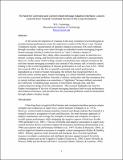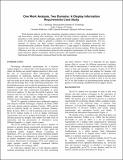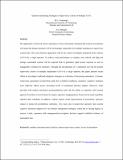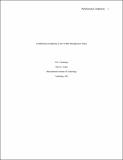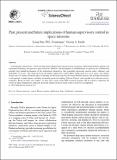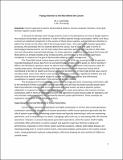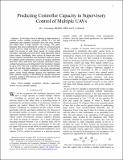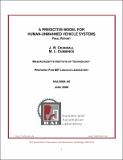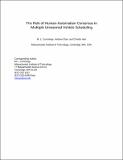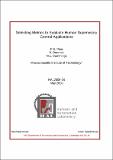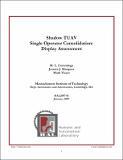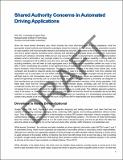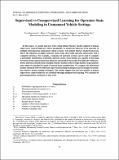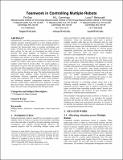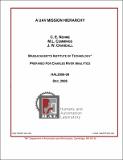Browsing Humans and Automation Laboratory by Title
Now showing items 47-66 of 69
-
The Need for Command and Control Instant Message Adaptive Interfaces: Lessons Learned from Tactical Tomahawk Human-in-the-Loop Simulations
(CyberPsychology and Behavior, 2004)In the recent development of a human-in-the-loop simulation test bed designed to examine human performance issues for supervisory control of the Navy’s new Tactical Tomahawk missile, measurements of operator situation ... -
One Work Analysis, Two Domains: A Display Information Requirements Case Study
(HFES, 2012)d observations, among other techniques. Given the time and resources required, we examine how to generalize a work domain analysis technique, namely the hybrid Cognitive Task Analysis (hCTA) method across two domains in ... -
Operator Choice Modeling for UAV Visual Search Tasks
(IEEE Transactions, 2012-09)Unmanned aerial vehicles (UAVs) provide unprecedented access to imagery of possible ground targets of interest in real time. The availability of this imagery is expected to increase with envisaged future missions of one ... -
Operator Objective Function Guidance for a Real-time Unmanned Vehicle Scheduling Algorithm
(AIAA Journal of Aerospace Computing, 2012-12)Advances in autonomy have made it possible to invert the typical operator-to-unmanned-vehicle ratio so that asingle operator can now control multiple heterogeneous unmanned vehicles. Algorithms used in unmanned-vehicle ... -
Operator Performance in Long Duration Control Operations: Switching from Low to High Task Load
(HFES, 2012-10)Long duration, low task load environments are typical for nuclear power plant control rooms, where operators, after hours of operating under a low task load situation, may have to shift to a high task load situation. The ... -
Operator Scheduling Strategies in Supervisory Control of Multiple UAVs
(Aerospace Science and Technology, 2007)The application of network centric operations to time-constrained command and control environments will mean that human operators will be increasingly responsible for multiple simultaneous supervisory control tasks. One ... -
Partitioning Complexity in Air Traffic Management Task
(International Journal of Aviation Psychology, 2006)Cognitive complexity is a term that appears frequently in air traffic control (ATC) research literature, yet there is little principled investigation of the potential sources of cognitive complexity. Three distinctly ... -
Past, Present And Future Implications Of Human Supervisory Control In Space Missions
(Acta Astronautica, 2008)Achieving the United States’ Vision for future Space Exploration will necessitate far greater collaboration between humans and automated technology than previous space initiatives. However, the development of methodologies ... -
Paying Attention to the Man behind the Curtain
(IEEE, 2011-03)In the push to develop smart energy systems, designers have increasingly focused on systems that measure and predict user behavior to effect optimal energy consumption. While such focus is an important component in these ... -
Predicting Controller Capacity in Remote Supervision of Multiple Unmanned Vehicles
(IEEE, 2008)In the future vision of allowing a single operator to remotely control multiple unmanned vehicles, it is not well understood what cognitive constraints limit how many vehicles and related tasks a single operator can manage. ... -
A Predictive Model for Human-Unmanned Vehicle Systems : Final Report
(MIT Humans and Automation Laboratory, 2008)Advances in automation are making it possible for a single operator to control multiple unmanned vehicles (UVs). This capability is desirable in order to reduce the operational costs of human-UV systems (HUVS), extend ... -
Predictive models of human supervisory control behavioral patterns using hidden semi-Markov models
(Engineering Applications of Artificial Intelligence, 2011)Behavioral models of human operators engaged in complex,time-critical high-risk domains, such as those typical in Human Supervisory Control (HSC) settings, are of great value because of the high cost of operator failure. ... -
The Role of Human-Automation Consensus in Multiple Unmanned Vehicle Scheduling
(The Role of Human-Automation Consensus in Multiple Unmanned Vehicle Scheduling, 2010)Objective: This study examined the impact of increasing automation replanning rates on operator performance and workload when supervising a decentralized network of heterogeneous unmanned vehicles. Background: Futuristic ... -
Selecting Metrics to Evaluate Human Supervisory Control Applications
(MIT Humans and Automation Laboratory, 2008)The goal of this research is to develop a methodology to select supervisory control metrics. This methodology is based on cost-benefit analyses and generic metric classes. In the context of this research, a metric class ... -
Shadow TUAV Single Operator Consolidation : Display Assessment
(MIT Humans and Automation Laboratory, 2007)Currently, Shadow UAV operations require two people: the Air Vehicle Operator (AVO) and the Mission Payload Operator (MPO). A previous workload study demonstrated that it is possible to combine these two positions such ... -
Shared Authority Concerns in Automated Driving Applications
(2014-05-13)Given the move toward driverless cars, which includes the more short-term goal of driving assistance, what the appropriate shared authority and interaction paradigms should be between human drivers and the automation remains ... -
Supervised vs. Unsupervised Learning for Operator State Modeling in Unmanned Vehicle Settings
(Journal of Aerospace Computing, Information, and Communication, 2011)In this paper, we model operator states using hidden Markov models applied to human supervisory control behaviors. More specifically, we model the behavior of an operator of multiple heterogeneous unmanned vehicle systems. ... -
Supporting Intelligent and Trustworthy Maritime Path Planning Decisions
(International Journal of Human Computer Studies, 2010)The risk of maritime collisions and groundings has dramatically increased in the past five years despite technological advancements such as GPS-based navigation tools and electronic charts which may add to, instead of ... -
Teamwork in controlling multiple robots
(ACM/IEEE, 2012)Simultaneously controlling increasing numbers of robots requires multiple operators working together as a team. Helping operators allocate attention among different robots and determining how to construct the human-robot ... -
A UAV Mission Hierarchy
(MIT Humans and Automation Laboratory, 2006)In the following sections, each of the primary missions are decomposed into mission planning, management, and replanning segments in order to identify what the primary functions a human operator will need to perform. The ...
